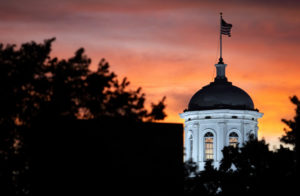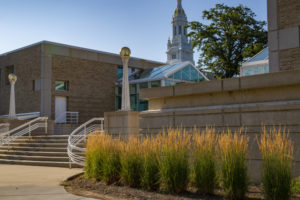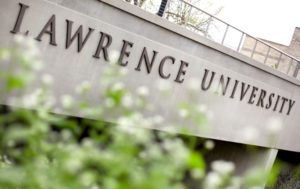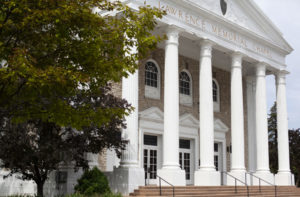Growing Up with Appleton
Celebrating Lawrence University’s 175-Year Anniversary
When you think of your childhood, there are major memories: the likely mixed emotions of a sibling being born, the sad reality of losing a loved one, schoolyard firsts and the somehow still vivid interactions with friends and family.
It’s impossible to be remiss about who we grew up with having a bearing on who we’ve become. The influence can be direct or inadvertent, but it’s foundationally a part of us.
It’s the same with landmarks and history.
Lawrence University’s impact on its students and the Fox Cities community has been going strong for 175 years—longer than Appleton has been a city.
“Lawrence and Appleton grew up together. Their histories and their futures are intertwined,” Ed Berthiaume, Director of Public Information at Lawrence, says. “Lawrence was founded almost six years before Appleton was first a municipality. (It was) named after Amos Lawrence who was our founder. His wife’s last name was Appleton. The city of Appleton is named after his wife.”

The Main Hall cupola is illuminated as the sun sets Sunday, July 26, 2020. Photo by Danny Damiani
When Lawrence was founded in 1847, it was the first institute of higher learning in Wisconsin to be coeducational, and one of the first in the country. Today, the university is made up of approximately 1500 students, the college of liberal arts and sciences making up 75% and the Conservatory of Music 25% of the student body.
“Both are world-class in terms of what they offer,” Berthiaume says. “Our faculty is world class. We draw students from almost all states across the country and upward of 40 countries. We’ve got a great mix of students. It’s always been that way. But at the same time, we’re also a destination for students closer to home.”
The downtown Appleton campus now includes 60 instructional, residential, recreational and administrative facilities. Björklunden, the 441-acre estate along the shores of Lake Michigan in Door County, continues to serve as an educational retreat for Lawrence students and alumni.
“The stewardship of the university has been really outstanding and thoughtful,” Berthiaume says. “Not all history is perfect, but Lawrence has evolved and it has grown and it’s been very intentional in moving in good, smart, insightful directions. It’s had really good leadership over the years.”
The “pay it forward” mentality between past and current students also plays a large part in its high rankings among schools.
“The connection between Lawrence and its alumni is really special. It’s amazing to watch,” he says. “We’re a private liberal arts college so a lot of what has happened in Lawrence’s history and what is going to happen in the future is a commitment from alumni to sort of move things forward and look out for the next generation. And that has been going on for multiple generations.
“They’re keeping in touch and they’re contributing to the future health of the university with their time, obviously with their treasures, their funding. There’s just an incredible bond between alumni and the university that is hard to put into words sometimes. It is special to see.”
 While national student debt has been rising, Lawrence’s has come down. In large part due to an effort to raise funds specifically for student scholarships.
While national student debt has been rising, Lawrence’s has come down. In large part due to an effort to raise funds specifically for student scholarships.
“A lot of what (alumni) have had to say is they want to provide opportunities for this generation and future generations to get the same opportunities at Lawrence that they got.”
An arts and culture destination for the community
“Lawrence has long provided an avenue for the Fox Cities community to enjoy world-class music, theater, opera, dance and other arts, often free or at little cost, as well as access to visiting scholars and other speakers,” Berthiaume says. “Then there’s the sporting events, access to gorgeous facilities overlooking the Fox River, the Community Music School, outreach with local schools and nonprofits. The list goes on and on. It’s a relationship Lawrence cherishes and wants to continue to strengthen going forward.”
The campus has been closed during the pandemic, but Berthiaume is hopeful the performances, theater productions and both student ensemble and professional musical groups will be available for the public to participate in soon.
“Those things, once we get back to normal—again, hopefully very soon—is something that Appleton and the Fox Cities can take advantage of literally on a weekly, if not daily, basis,” Berthiaume says. “It’s an ongoing gift to the community.”
The Center for Community Engagement & Social Change offers another avenue of current students positively affecting the community and strengthening the relationship between the two for years to come.
The Center designs and develops opportunities for students to connect with local nonprofits and municipal agencies for volunteerism and service-learning.
“Our programs allow students to engage with pressing social issues, apply their academic learning to solve real-world problems in the Fox Cities and provide our community partners with valuable and consistent capacity,” Garrett Singer, Director of the Center for Community Engagement & Social Change, says.
“These opportunities are deeply important to the student experience, as they bridge the gap between classroom and community,” Singer says. “Students are able to apply knowledge from their various courses to support local organizations in ways that are meaningful, tangible and—perhaps most importantly—measurable.”

Hurvis Crossing Tuesday, May 19, 2020.
You’re invited!
The university is hosting three major weekend events—one of which, held Jan. 14-15 recognized its founding—throughout the year to commemorate the 175-year anniversary milestone.
May 13 will mark the inauguration of President Laurie Carter, and will roll into a community event on May 14.
“The Fox Cities community is welcome to join the Lawrence community on campus for a celebration that will include food, music, topical discussions, games, entertainment and more. Details will be shared in the weeks leading up to the event,” Berthiaume says. “We really want to make this an opportunity to reflect and celebrate our relationship with the larger community. Appleton is better for having Lawrence here and Lawrence is better for having Appleton here. We’re in this together. We’ve grown up together.”
A traditional Blue & White Homecoming Celebration will take place October 7-8. Lawrence alumni will be invited back to campus and will join with current students, faculty and staff to mark the 175th anniversary. The weekend of events will be wrapped around a football game at Banta Bowl.
While much has been written about Lawrence University, Berthiaume is interested in the lesser known background as well.
“We’re trying to tell some of the stories of Lawrence’s history and we’re trying to engage students, alumni, faculty, the Appleton/Fox Cities community,” he says. “Are there hidden stories of Lawrence, things in our history, that maybe aren’t widely known? We want to tell stories that aren’t just repeating what we’ve already written about. We want people to say, ‘Oh wow, I didn’t know that.’”
175 Years of Lawrence
Jan. 15, 1847: The Territorial Legislature grants Lawrence Institute a charter.
Nov. 12, 1849: Name changed to Lawrence University and first classes begin.
1853: Main Hall opens.
1904 – Conservatory of Music established.
1913: The institution adopted the name Lawrence College to underscore its commitment to undergraduate liberal education.
1918: Memorial Chapel opens.
1928-29: Alexander Gym opens.
1964: Lawrence once again assumed the name Lawrence University as it consolidated with Milwaukee-Downer College.
1965: Banta Bowl opens (originally known as Lawrence Bowl; renamed in 1978).
1974-76: Seeley G. Mudd Library opens.
1989: Wriston Art Center opens.
2009: Warch Campus Center opens.

Memorial Chapel Wednesday, June 30, 2021. Photo by Danny Damiani
Famous Faces
Lawrence University has had its fair share of big names visit campus—from political leaders and acclaimed writers to world-renowned musicians:
William Howard Taft, 1911: This is the first and only time a sitting president has come to the Lawrence campus.
Marian Anderson, 1941: The celebrated contralto who paved the way for other Black artists performed Memorial Chapel.
Louis Armstrong, 1960: The jazz pioneer nicknamed “Satchmo” made a late-career visit to Lawrence’s Memorial Chapel.
John Lewis, 1964, 2005, 2015: In June 2015, Rep. John Lewis returned to Lawrence to deliver the Commencement address in the 50th anniversary year of the passage of the Voting Rights Act. It was his third visit to campus.
Maya Angelou, 1976 and 1997: The poet, memoirist, and civil rights activist spoke at Lawrence on two occasions.
Yo-Yo Ma, 1986: One of the most accomplished cellists of all time paid a visit to Memorial Chapel at age 31. He was fresh off winning the first of 18 Grammy Awards.
Marilyn Horne, 1994: The American mezzo-soprano sits among the greatest voices of opera. She performed at Memorial Chapel.
Jane Goodall, 2001: On Oct. 26, the famed wildlife researcher spoke in Memorial Chapel, part of the Jane Goodall Institute lecture tour. The visit was coordinated through the nearby Mosquito Hill Nature Center.
Lech Walesa, 2001: The former president of Poland and winner of the Nobel Peace Prize came to Lawrence to deliver a convocation address.
Michelle Obama, 2012: The first lady spoke Sept. 28 at Alexander Gymnasium, a campaign stop on behalf of her husband, President Barack Obama, who would be re-elected five weeks later. She is the only sitting first lady to visit Lawrence.










Leave a Comment